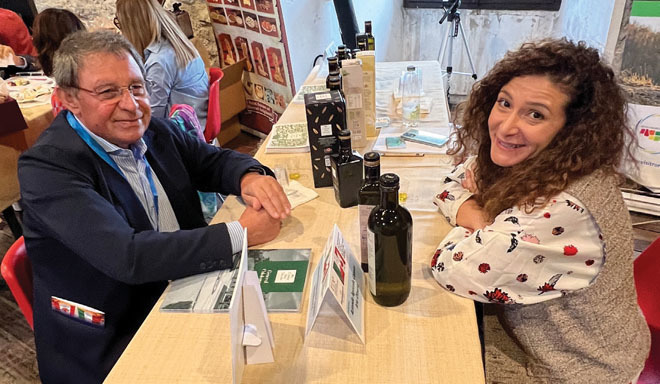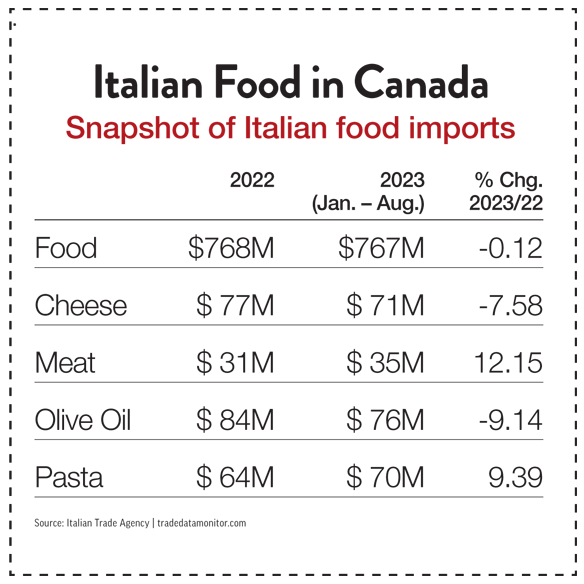Discovering the Undiscovered – Grocery Business Magazine

Italy trade mission puts spotlight on unexplored food regions of the country
When people think of Italian foods, well-known products such as Parmigiano Reggiano cheese or Modena balsamic vinegar come to mind. But Italy offers an abundance of varied foods, from pasta, preserves and meats to olive oil, sweets and nuts, and the Italian Trade Agency (ITA) is on a mission to showcase foods from some of the lesser-known areas in Emilia Romagna and Calabria.
Grocery Business was part of a trade mission that included several Canadian importers in search of new regional foods to bring to Canadian kitchens.

Canadians and Italian cuisine
Italian is the most popular cuisine Canadian consumers cook at home (73%), according to data from Statista, January 2022. And Italy ranks second among top food suppliers to Canada behind the U.S. In fact, according to data from the Italian Trade Agency, Italian imports into Canada have been trending upward, with food imports growing 28% in 2022 versus 2021.
Canada is a popular export market in part because Canadian consumers like to experience other cultures through food, and are more open to trying ethnic foods, according to research from Mintel.
It’s a point that Giorgio Tinelli, trade analyst with ITA, stressed with importers attending the trade mission. “Canada is a multicultural country and it’s not just Italians buying foods from Italy. There are opportunities to showcase Italian foods to other ethnic groups in the country who are eager to try new cuisines.”
Beyond new and novel
For trade mission delegates, it’s no surprise most are on the lookout for the new and novel, but there is more to consider, says Fiorella Bonantoni, director of purchasing for Jan K. Overweel.
“When we meet a company offering a product that we think is interesting, it’s also about how we can help them succeed in the Canadian market. Sometimes they may not be aware of the hurdles involved in getting into the market. I found the companies to be enthusiastic and everyone emphasized the authenticity of their products. Some of the products, while interesting, would fall into the premium category, which is a niche market and I think may be difficult to deal with in the current price-conscious market.”
Gesualdo Mastruzzi, founder of Numage Trade, which merged with Tree of Life in 2019, says he found several products of interest that he thinks could do well in Canada. While not identifying the specific products, he says for him the story behind a product is important and this must be conveyed to consumers, so they understand the value of an authentic, high-quality artisanal food.

“I’ve participated in many of these trade missions and have met with hundreds of companies, and out of that, usually there are maybe 10 that offer a good possibility as an export product to Canada, and that’s normal,” says Mastruzzi. “The Confartigianato who organize these trips represent small artisanal companies and not all of these companies offer products suitable for Canada, but unless you go on these trips and talk with these companies, you’ll never know if there is potential for an interesting product to be exported into Canada.”
Alberto Restivo, director of procurement at Aurora Importing and Distributing, says he was impressed with several products that he thinks would be a good fit for Canada.
“Of course, I always look for products that are unique but what is important for us is to understand a company’s ability to supply volumes we may need. Sometimes, the products are interesting and of excellent quality but if the company is small and doesn’t have the ability to provide a certain volume, it’s not cost effective for us to take on the product.”
Regional tastes, unique offerings
While both regions offer distinctive foods and beverages that reflect their respective geographic landscape, a common characteristic among producers is a pride in the quality of the food they make and the focus on creating them with clean and simple ingredients.
In Emilia Romagna, Riccione Piadina makes a regional flatbread called “piadina,” typically made with three simple ingredients – white flour, olive oil, salt and water. Emporio Pasta uses controlled-quality durum wheat flours and semolina, yellow eggs and PDO (Protected Designation of Origin) products such as Parmigiano Reggiano and Italian-certified vegetables to make its pasta.
In Calabria, Nduja is a spicy, spreadable, finely minced pork sausage and one company, Sap Salumi, has created a dried-format version that can be used as a topping for pizza or other foods. Sapori Antichi has unique products of the region in innovative offerings, such as using local chestnuts to create flours, local tomatoes to create 100 per cent tomato flour and tomato sauce made from yellow tomatoes.
An artisanal distinction
History and tradition are important elements of the foods made in Italy, and this was evident in the number of artisanal and multi-generational food companies encountered during the trade mission. Indeed, the stories behind the products fit in with research that indicates consumers such as Gen Zs seek out foods and beverages with unique stories that are authentic and made from high-quality ingredients.
For example, Luigia Dolciaria is a third generationrun sweets company based in Rimini, a city in Emilia Romagna, that was formed by Domenico Balocchi in 1930. He crafted sweets by hand, a process the company continues to use today to make an array of offerings, such as panettoni and torrone (nougat). Another example is Parma certified extra virgin olive oil producer Coppini Arte Olearia. The company was formed by Americo Coppini, a master cheesemaker, in 1946 and is run today by second and third generation family members.


Source: grocerybusiness.ca

